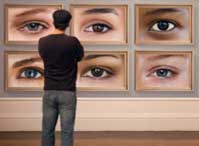 Although the balance system is quite complex, its integrated components can be easily explained. Take, for example, a person climbing up a hill. First, proper function of the eyes and visual system are necessary for the body to understand where it is in space. The transmission of this visual information from the eyes to the brain occurs via the circulatory system, similar to the way that water flows through a pump to create hydraulic energy.
Although the balance system is quite complex, its integrated components can be easily explained. Take, for example, a person climbing up a hill. First, proper function of the eyes and visual system are necessary for the body to understand where it is in space. The transmission of this visual information from the eyes to the brain occurs via the circulatory system, similar to the way that water flows through a pump to create hydraulic energy.
Second, the brain must work properly to process the visual information it receives so that it can instruct the body to adjust its position in space. Continuing along with the earlier example, it might signal the left leg to lift to accommodate a rise in the hill under its left foot. The muscles receive information from the brain via the spinal cord and nervous system in the same way that a television receives its programming via electricity through the electrical system. Positional information from each side of the body is independently transmitted to the brain. Typically, it is received from both sides simultaneously. When there is a delay on one side, the body receives, processes and acts on the information received from the first side. When information arrives from the second side, it tries to adjust and act accordingly, but this alteration often leads to a marked sense of imbalance.
Thirdly, the body simultaneously adjusts and verifies its position in space by using the inner ear labyrinth as a level to confirm proper positioning.
Not all balance disorders are the result of a problem originating in the ear. In fact, many are the result of reduced blood flow because of a narrowing or blockage of one or more blood vessels in the neck or in the head. These blockages can be from atherosclerosis or from external compression caused by conditions such as arthritis or bone spurs in the neck and upper spine. Generally, in these instances, the imbalance is brought on by head movement or positioning. In other cases, herniated discs, traumatic and/or chronic back problems, and nerve transmission disorders can be causes of imbalance or unsteadiness due to reduced transmission in the nervous system.
Balance Disorders
A balance disorder can make you feel wobbly, unsteady and/or dizzy, as if you were on a rocking ship, spinning, falling or floating—even though you’re not moving at all. People with severe balance disorders may suffer from confusion, depression, anxiety, and fatigue as well as host of other physical symptoms including blurred vision, nausea, and changes in heart rate and blood pressure. These symptoms may come and go or last for extended periods. Not surprisingly, balance disorders can interfere with your ability to work, concentrate, or even leave the house!
What Causes Balance Disorders That Originate in the Ear?
Some of the most common causes include a viral or bacterial infection that can cause fluid in the middle ear or inflammation of the inner ear. At times, there may be no obvious cause. Here are some common causes:
Positional vertigo
This condition is marked by a short but intense episode of dizziness, lasting seconds to minutes, and it occurs typically when you change the position of your head as, for example, when you turn over in bed or turn to look as you’re backing your car out of the garage. It’s sometimes caused by trauma but can be a result of conditions like arthritis that are inherent in the aging process.
Vestibular neuronitis
The usual symptom of this condition is dizziness that lasts hours to days. It may be associated with or occur shortly after an upper respiratory infection. It is caused by inflammation of the vestibular nerve, also known as the eighth cranial nerve or the nerve of balance. Viruses are often to blame.
Perilymph fistula
Unsteadiness while standing or walking plus nausea and dizziness can develop after head trauma, ear surgery, intense physical effort, repeated ear infections, or drastic changes in atmospheric pressure. Perilymph fistula can even be a congenital condition. It is usually accompanied by hearing loss.
Labyrinthitis
When the labyrinth structure of the inner ear becomes inflamed, it causes imbalance and dizziness. Labyrinthitis is frequently caused by flu or other upper respiratory viral infection.
Ménière’s disease
This condition causes intermittent and often irregular hearing loss, vertigo, tinnitus (ringing in the ears), and an uncomfortable feeling of fullness in the ear. The causes of this condition are not known.
Mal de debarquément syndrome(Translation: Disembarkation sickness.)
If you’ve ever gotten off a boat and felt like you were still on one, you’ve experienced this condition. Although it usually goes away in a few hours or days at most, some people experience lingering effects for months or even years!
In New York (NY), Manhattan, and NYC, if you think you have a balance disorder, you should consult an otolaryngologist (ENT) like Dr. Yagoda who specializes in the care of the ear, nose, and throat from her office in Manhattan, New York (NY). With a detailed history and physical examination, and perhaps some blood work and a hearing test, ENG (electronystagmography) and/or posturography, the source of the imbalance can be traced and treated. Treatments for balance disorders range from vestibular strengthening exercises and simple dietary adjustments to medications and surgery. The right course of treatment for you will depend on the type of balance order, the condition of your hearing, and the extent to which it interferes with your life.


































